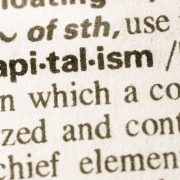Democracies are much richer than non-democracies and their wealth has made them the envy of the world. The close correlation between democracy, high GDP per capita, and economic, military, and cultural power has made modernity appear to be a package deal. When people look at rich, powerful countries they typically see a democracy and they think, “I want that.”
At the same time, however, the academic literature on the causal effect of democracy on growth has shown at best weak results. Here is the all-star team of Acemoglu, Naidu, Restrepo, and Robinson (ungated) in the JPE summarizing:
With the spectacular economic growth under nondemocracy in China, the eclipse of the Arab Spring, and the recent rise of populist politics in Europe and the United States, the view that democratic institutions are at best irrelevant and at worst a hindrance for economic growth has become increasingly popular in both academia and policy discourse. For example, the prominent New York Times columnist Tom Friedman (2009) argues that “one-party non democracy certainly has its drawbacks. But when it is led by a reasonably enlightened group of people, as China is today, it can also have great advantages. That one party can just impose the politically difficult but critically important policies needed to move a society forward in the 21st century. ”Robert Barro (1997, 1) states this view even more boldly: “More political rights do not have an effect on growth.”
Although some recent contributions estimate a positive effect of democracy on growth, the pessimistic view of the economic implications of democracy is still widely shared. From their review of the academic literature until the mid-2000s, Gerring et al. (2005, 323) conclude that “the net effect of democracy on growth performance cross-nationally over the last five decades is negative or null.”
Acemoglu et al. continue, “In this paper, we challenge this view.” Indeed, using a multitude of sophisticated econometric strategies, Acemoglu et al. conclude “Democracy Does Cause Growth.” In their sample of 175 countries from 1960 to 2010, Acemoglu et al. find that democracies have a GDP per-capita about four times higher than nondemocracies ($2074 v. $8149). (This is uncorrected for time or other factors.) But how much of this difference is explained by democracy? Hardly any. Acemoglu et al. write:
Our estimates imply that a country that transitions from nondemocracy to democracy achieves about 20 percent higher GDP per capita in the next 25 years than a country that remains a nondemocracy.
In other words, if the average nondemocracy in their sample had transitioned to a democracy its GDP per capita would have increased from $2074 to $2489 in 25 years (i.e. this is the causal effect of democracy, ignoring other factors changing over time). Twenty percent is better than nothing and better than dictatorship but it’s weak tea. GDP per capita in the United States is about 20% higher than in Sweden, Denmark or Germany and 40% higher than in France but I don’t see a big demand in those countries to adopt US practices. Indeed, quite the opposite! If we want countries to adopt democracy, twenty percent higher GDP in 25 years is not a big carrot.
As someone who favors democracy as a limit on government abuse, I find this worrying. One optimistic response is that the nondemocracies that adopt the policies necessary to make a nation rich, such as support for property rights, open markets and the free exchange of ideas, may not be such bad places. These beasts, however, appear to be rare. But if they are truly rare there must be more to the democracy-GDP per capita correlation than Acemoglu et al. estimate. So what are they missing? I am uncertain.
If democracies don’t substantially increase growth, why are they rich? Acemoglu et al. don’t spend time on this question but the answer appears to be reverse causality (from wealth to democracy) and the fact that today’s rich democracies adopted capitalism early. But don’t expect the wealth to democracy link to be everywhere and always true, it’s culturally and historically bound. And catch-up is eliminating the benefits of the head start.
If much of the allure of democracy has been higher GDP per capita then the allure has been a mistake of confusing correlation for causation. A fortunate mistake but a mistake. The literature on democracy and growth implies that there is no reason to reject an alternative history in which the world’s leading industrial economy was a nondemocracy. Nor why we could not see some very rich nondemocracies in the future–nondemocracies that would be as on par with the United States as say Sweden, Denmark and Germany are today. If that happens, the case for democracy will look very much weaker than it does now as the correlation between democracy and wealth will be broken and the causal effect more evident even to those without sophisticated econometrics.













